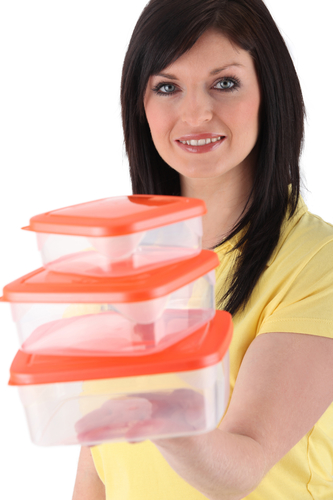Basics for Handling Food Safely
 Handling Food Safely
Handling Food Safely
Safe steps for food handling, cooking and storage are essential for avoiding food borne illnesses. You can’t see, smell or taste bacteria which may be on any food. Follow these safety guidelines to keep pathogens away.
Buy cold food fast; get it home fast
- Never chose packages which are torn or leaking
- Don’t buy foods past “sell-by” or expiration dates.
- Put raw meat and poultry into a plastic bag so meat juices wont cross contaminate cooked foods or those eaten raw, such as vegetables or fruit.
- Place refrigerated or frozen items in the shopping cart last, right before heading or the checkout counter.
- When loading the car, keep perishable items inside the air-conditioned car – not in the trunk.
- Drive immediately home from the grocery. If you live further away than 30 minutes bring a cooler with ice from home; place perishables in it.
Safe Storage of Foods
- Woman holding stack of plastic food storage
- Unload perishable foods from the car first and immediately refrigerate them. Place securely wrapped packages of raw meat, poultry, or fish in the meat drawer or coldest section of your refrigerator.
- Check the temperature of your unit with an appliance thermometer. To slow bacterial growth, the refrigerator should be 40 degrees F; the freezer 0 degrees F.
- Cook or freeze fresh poultry, fish, ground meats, and variety meats within 2 days; other beef, veal, lamb or pork, within 3 to 5 days.
- Keep meat and poultry in its package until just before using.
- If freezing meat and poultry in its original package longer than 2 months, over wrap these packages with airtight heavy-duty foil, plastic wrap, freezer paper or plastic freezer bags.
- Meat and poultry defrosted in the refrigerator may be refrozen before or after cooking. If thawed by other methods, cook before refreezing.
Keep Everything Clean
- Wash hands before and after handling raw meat and poultry
- Sanitize cutting boards often in a solution of 1 teaspoon chlorine bleach in 1 quart of water. Wash towels and cloths often in hot water. Wash kitchen towels and cloths often in hot water in washing machine.
- Don’t cross-contaminate. Keep raw meat, poultry, fish and other juices away from other food. After cutting raw meats, wash hands, cutting board, knife, and counter tops with hot soapy water.
- Marinate meat and poultry in a covered dish in the refrigerator.
Thaw Food Safely
- Refrigerator: Allows slow, safe thawing. Make sure thawing juices do not drip on other foods.
- Cold Water: For faster thawing, place food in a leak-proof plastic bag and submerge in cold tap water.
- Microwave: Cook meat and poultry immediately after microwave thawing.
Safe Cooking
Cook all meat and poultry to the proper internal temperatures:
Ground meats to 160 degrees F
Ground poultry to 165 degrees F
Beef to 145 degrees F
Veal and lamb shanks to 145 degrees F
Roasts to 145 degrees F
Chops to 145 degrees F
All cuts of fresh pork to 160 degrees F
Poultry thighs to 180 degrees F
Poultry breasts to 170 degrees F
Serving Foods Safely
Never leave it out over 2 hours (1 hour in temperatures above 90 degrees F): Bacteria that cause food borne illness grow rapidly in room temperature.
Keep Hot Food hot! Cold Food Cold:
- When serving food at a buffet, keep hot food over a heat source and keep cold food on ice. Keep platters of food refrigerated until time to serve or heat them.
- Carry perishable picnic foods in a cooler with a cold pack or ice. Set the cooler in the shade and open the lid as little as possible.
Handing Leftover Safely
- Divide foods into shallow containers for rapid cooling. Put food directly in the refrigerator or freezer.
- Cut turkey off the bone and refrigerate. Slice breast meat, legs and wings may be left whole.
- Use cooked leftover within 4 days.
Refreezing Foods
Meat and poultry defrosted in the refrigerator may be refrozen before OR after cooling. If thawed by other methods, cook before refreezing.
 Cold Storage Chart
Cold Storage Chart
Eggs
Refrigerator/Freezer
Fresh, in shell 3 weeks do not freeze
Raw yolks, white 2 – 4 days 1 year
Hard cooked 1 week do not freeze well
Liquid egg substitute,
opened 3 days do not freeze
Liquid egg substitute,
unopened 10 days 1 year
Frozen Prepared Dinners (see also Serving Prepared Foods Safely)
Refrigerator/Freezer
All Frozen until ready to heat 3 – 4 months
Deli & Prepared Foods
Refrigerator/Freezer
Egg salad 3 – 5 days do not freeze well
Chicken, tuna, ham salads 3 – 5 days do not freeze well
Pasta salads 3 – 5 days do not freeze well
Pre-stuffed pork/lamp chops 1 day do not freeze well
Stuffed chicken breasts 1 day do not freeze well
Store-cooked convenience meats 3 – 4 days do not freeze well
Hot Dogs & Lunch Meat
Refrigerator/Freezer
Hot dogs, opened 1 week 1 – 2 months
Hot dogs, unopened 2 weeks 1 – 2 months
Lunch meat, opened 3 – 5 days 1 – 2 months
Lunch meat, unopened 2 weeks 1 – 2 months
Corned Beef & Ham
Refrigerator/Freezer
Corned beef, with juice 5 – 7 days drained, 1 month
Refrigerated canned ham
unopened 6 – 9 months do not freeze
opened 3 – 5 days 1 – 2 months
Ham, fully cooked, whole 7 days 1 – 2 months
Ham, fully cooked, half 3 – 5 days 1 – 2 months
Ham, fully cooked, slices 3 – 4 days 1 – 2 months
Raw Hamburger, Ground & Stew Meats – How long is hamburger meat good for?? And others, of course.
Refrigerator/Freezer
Hamburger & stew meats 1 – 2 days 3 – 4 months
Ground turkey 1 – 2 days 3 – 4 months
Ground veal 1 – 2 days 3 – 4 months
Ground pork 1 – 2 days 3 – 4 months
Ground lamb 1 – 2 days 3 – 4 months
Soups & Stews
Refrigerator/Freezer
Vegetable or meat added 3 – 4 days 2 -3 months
Bacon & Sausage
Refrigerator/Freezer
Bacon 7 days 1 month
Pork sausage 1 – 2 days 1 -2 months
Beef sausage 1 – 2 days 1 – 2 months
Chicken or turkey sausage 1 – 2 days 1 – 2 months
Smoked breakfast links 7 days 1 – 2 months
Smoked breakfast patties 7 days 1 – 2 months
Refrigerated summer sausage unopened 3 weeks 1 – 2 months
opened 3 weeks 1 – 2 months
Fresh Meat
Refrigerator/Freezer
Steaks 3 – 5 days 6 – 12 months
Chops 3 – 5 days 4 – 6 months
Roasts 3 – 5 days 4 – 12 months
Organ meats 1 – 2 days 3 – 4 months
Meat Leftovers
Refrigerator Freezer
Cooked meat and meat dishes 3 – 4 days 2 – 3 months
Gravy and meat broth 1 – 2 days 2 – 3 months
Fresh Poultry
Refrigerator/Freezer
Chicken or turkey, whole 1 – 2 days 1 year
Chicken or turkey, parts 1 – 2 days 9 months
Giblets 1 – 2 days 3 – 4 months
Cooked Poultry
Refrigerator/Freezer
Fried chicken 3 – 4 days 4 months
Cooked poultry dishes 3 – 4 days 4 – 6 months
Pieces, plain 3 – 4 days 4 months
Pieces, with broth/gravy 1 – 2 days 6 months
Chicken nuggets, patties 1 – 2 days 1 -3 months
Because freezing (0 Degree F) keeps food safe indefinitely, recommended storage times are for quality only.
For more information go to Still Tasty? – Keep it or Toss It? How long will your favorite food or beverage stay safe and tasty? What’s the best way to store it?
More info: Call USDA Meat & Poultry Hotline:
1-800-535-4555
Washington DC (202) 720-3333
Fast Food: 1 (800) 238-8281
Get Natural Vitamins that deliver – go to Whole Food Supplements
Sign up to receive the MCVitamins Newsletter!
Up-to-date info on the latest health-related news happening in the world
(available in English only)

